Teeny weeny Linux SBCs
Mar 9, 2002 — by LinuxDevices Staff — from the LinuxDevices Archive — 567 viewsUpdated Mar 10, 2009 — A growing number of extremely small, yet highly integrated, single board computers (SBCs) make it increasingly easy to embed Linux in a wide range of applications, from handheld devices to embedded instruments. Typically, you can get all the functions of a full computer system — including CPU, program memory, “solid-state disk”, serial and parallel ports, display interface, and network interface — in less than a dozen square inches of space. A few even manage to cram an embedded Linux computer into under three square inches!
Some of these products also provide CompactFlash or PCMCIA slots, which facilitate both memory and peripheral interface expansion. Many now include support for operation from batteries, making them ideal platforms for specialized handheld and portable equipment.
One noteworthy concern relative to this class of products, with the exception of PC/104 form-factor SBCs (which are too numerous to include here), is the utter lack of plug-and-play interoperability among these tiny modular systems. Although there is the hint of a trend toward matching the size and connector styles of DIMM or SIMM memory modules, there is no consistency whatsoever in how their signals are assigned to the module connectors. Also, with many of these products taking advantage of the latest high-integration system-on-chip processors (StrongARM, Elan, Etrax, etc.), which are not typically x86 compatible, PC compatibility has become the exception rather than the rule.
However, despite their lack of plug-and-play interoperability, the availability of embedded Linux ports for these tiny boards, combined with their excellent integration/size ratios, make these products highly appealing for applications that can't tolerate the size of standards-compliant SBCs. The hope, of course, is that using one of these tiny single-module-systems will eliminate the costly, risky, and time-consuming process of developing a custom embedded computer.
Here, then, is a sampling of some “teeny weeny” embedded-SBCs that support embedded Linux, in date order (newest at the top)…
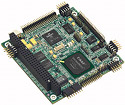 ADlink CoreModule 430 — Mar. 10, 2009 — ADlink’s latest PC/104 SBC is based on DMP Electronics’s x86-compatible Vortex86SX SoC. The “CoreModule 430” includes 256MB of RAM, four serial ports, 10/100 Ethernet, two USB ports, and support for both CRT and TFT displays.
ADlink CoreModule 430 — Mar. 10, 2009 — ADlink’s latest PC/104 SBC is based on DMP Electronics’s x86-compatible Vortex86SX SoC. The “CoreModule 430” includes 256MB of RAM, four serial ports, 10/100 Ethernet, two USB ports, and support for both CRT and TFT displays. Kontron pITX-SP — Mar. 10, 2009 — Kontron’s first pico-ITX SBC is built around a 1.1GHz or 1.6GHz Intel Atom Z5xx CPU. Targeting small, multimedia-oriented devices, the “pITX-SP” offers gigabit Ethernet, two SATA II ports, a microSD slot, and a DVI port.
Kontron pITX-SP — Mar. 10, 2009 — Kontron’s first pico-ITX SBC is built around a 1.1GHz or 1.6GHz Intel Atom Z5xx CPU. Targeting small, multimedia-oriented devices, the “pITX-SP” offers gigabit Ethernet, two SATA II ports, a microSD slot, and a DVI port. Ka-Ro Triton TX37 — Mar. 09, 2009 — This Ka-Ro Electronics processor module is based on Freescale’s i.MX37 SoC. The “Triton TX37” runs embedded Linux, measures 2.6 x 1 x 0.16 inches (67.6 x 26 x 4.2 mm), and fits into an SODIMM (small outline dual in-line memory module) slot.
Ka-Ro Triton TX37 — Mar. 09, 2009 — This Ka-Ro Electronics processor module is based on Freescale’s i.MX37 SoC. The “Triton TX37” runs embedded Linux, measures 2.6 x 1 x 0.16 inches (67.6 x 26 x 4.2 mm), and fits into an SODIMM (small outline dual in-line memory module) slot.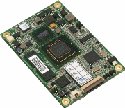 Aaeon NanoCOM-U15 — Mar. 09, 2009 — Aaeon’s COM exploits the newly proposed “COM Express Ultra” standard. The 84 x 55mm NanoCOM-U15 includes an SDVO (serial digital video out) connector, an Intel Atom Z5xx-series CPU, and up to 4GB of SSD (solid state disk) storage.
Aaeon NanoCOM-U15 — Mar. 09, 2009 — Aaeon’s COM exploits the newly proposed “COM Express Ultra” standard. The 84 x 55mm NanoCOM-U15 includes an SDVO (serial digital video out) connector, an Intel Atom Z5xx-series CPU, and up to 4GB of SSD (solid state disk) storage. SSV eSOM/2586 — Mar. 04, 2009 — SSV’s 3.1 x 2.0-inch (80 x 50mm) processor module is based on an x86-compatible VortexDX system-on-chip (SoC). Supplied with Debian Linux, the eSOM/2586 is the first in a planned series of processor modules based on a custom “eSOM-200” form factor.
SSV eSOM/2586 — Mar. 04, 2009 — SSV’s 3.1 x 2.0-inch (80 x 50mm) processor module is based on an x86-compatible VortexDX system-on-chip (SoC). Supplied with Debian Linux, the eSOM/2586 is the first in a planned series of processor modules based on a custom “eSOM-200” form factor. Digi ConnectCore 9M 2443 and ConnectCore Wi-9M 2443 — Mar. 04, 2009 — Based on an ARM9 Samsung S3C2443 SoC, these two network-enabled embedded modules from Digi International target networked displays, medical devices, building access controls, energy management devices, time and attendance devices, and scales. The ConnectCore 9M 2443 and WiFi-enabled ConnectCore Wi-9M 2443 offer a variety of interfaces, including Ethernet, USB, serial, and camera support.
Digi ConnectCore 9M 2443 and ConnectCore Wi-9M 2443 — Mar. 04, 2009 — Based on an ARM9 Samsung S3C2443 SoC, these two network-enabled embedded modules from Digi International target networked displays, medical devices, building access controls, energy management devices, time and attendance devices, and scales. The ConnectCore 9M 2443 and WiFi-enabled ConnectCore Wi-9M 2443 offer a variety of interfaces, including Ethernet, USB, serial, and camera support. Toradex Robin — Feb. 27, 2009 — This credit card-sized COM Express module from Toradex is based on Intel’s Z5xx Atom processor. Available in 1.6GHz Z530 and 1.1GHz Z510 models, the “Robin” board is equipped with seven USB 2.0 ports, gigabit Ethernet, an SATA port, and a microSD slot.
Toradex Robin — Feb. 27, 2009 — This credit card-sized COM Express module from Toradex is based on Intel’s Z5xx Atom processor. Available in 1.6GHz Z530 and 1.1GHz Z510 models, the “Robin” board is equipped with seven USB 2.0 ports, gigabit Ethernet, an SATA port, and a microSD slot.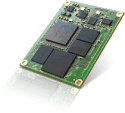 Armadeus APF27 — Feb. 26, 2009 — Armadeus Systems’s low-cost system-on-module (SOM) is available with a development board and a Linux community distribution. The “APF27” processor module is built around an ARM9 Freescale i.MX27 system-on-chip (SoC) and a Xilinx Spartan3A FPGA, and offers a variety of I/O.
Armadeus APF27 — Feb. 26, 2009 — Armadeus Systems’s low-cost system-on-module (SOM) is available with a development board and a Linux community distribution. The “APF27” processor module is built around an ARM9 Freescale i.MX27 system-on-chip (SoC) and a Xilinx Spartan3A FPGA, and offers a variety of I/O. SSV DIL/NetPC DNP/2486 — Feb. 25, 2009 — SSV’s x86-compatible computer-on-module (COM) measures 3.2 by 1.1-inches (81 x 28mm), and targets TCP/IPv4-6 embedded networking applications. Attaching to custom I/O boards via “DIL” (dual in line) sockets, the DIL/NetPC DNP/2486 runs an IPv6-ready Debian Linux stack on a 300MHz Vortex86SX system-on-chip (SoC).
SSV DIL/NetPC DNP/2486 — Feb. 25, 2009 — SSV’s x86-compatible computer-on-module (COM) measures 3.2 by 1.1-inches (81 x 28mm), and targets TCP/IPv4-6 embedded networking applications. Attaching to custom I/O boards via “DIL” (dual in line) sockets, the DIL/NetPC DNP/2486 runs an IPv6-ready Debian Linux stack on a 300MHz Vortex86SX system-on-chip (SoC). Embedian MXM-6410 COM — Feb. 19, 2009 — Embedian’s Linux-ready ARM11 MXM computer-on-module (COM) and evaluation kit supports videoconferencing. The MXM-6410 COM features the Samsung S3C6410 SoC with an ARM1176JZF-S core clocked to 667Mhz, and a multimedia co-processor for encoding and decoding MPEG4/H.263/H.264 and decoding VC1.
Embedian MXM-6410 COM — Feb. 19, 2009 — Embedian’s Linux-ready ARM11 MXM computer-on-module (COM) and evaluation kit supports videoconferencing. The MXM-6410 COM features the Samsung S3C6410 SoC with an ARM1176JZF-S core clocked to 667Mhz, and a multimedia co-processor for encoding and decoding MPEG4/H.263/H.264 and decoding VC1.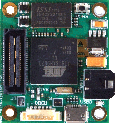 Calao TNY-A9G20-C0x, TNY-A9260-C0x, and TNY-A9263-C0x — Feb. 09, 2009 — Calao Systems’s Linux-ready “TinyCore” modules are offered with Atmel’s ARM9-based processors, including the 400MHz AT91SAM9G20, 200MHz AT91SAM9263, and 180MHz AT91SAM9260. The TNY-A9G20-C0x, TNY-A9260-C0x, and TNY-A9263-C0x modules each measure a scant 1.4 x 1.6 inches, and ship with 64MB of SDRAM, 256MB of flash, micro-USB connections, serial debug interface, and other I/O.
Calao TNY-A9G20-C0x, TNY-A9260-C0x, and TNY-A9263-C0x — Feb. 09, 2009 — Calao Systems’s Linux-ready “TinyCore” modules are offered with Atmel’s ARM9-based processors, including the 400MHz AT91SAM9G20, 200MHz AT91SAM9263, and 180MHz AT91SAM9260. The TNY-A9G20-C0x, TNY-A9260-C0x, and TNY-A9263-C0x modules each measure a scant 1.4 x 1.6 inches, and ship with 64MB of SDRAM, 256MB of flash, micro-USB connections, serial debug interface, and other I/O. Congatec conga-BA945 — Feb. 06, 2009 — This Congatec COM measures 4.92 x 3.75 inches, uses an Intel Atom processor, and targets “mobile and fanless” applications. The conga-BA945 has a COM Express form factor, accepts a whopping 4GB of RAM, has eight USB ports and two serial ports, and includes PCIe expansion.
Congatec conga-BA945 — Feb. 06, 2009 — This Congatec COM measures 4.92 x 3.75 inches, uses an Intel Atom processor, and targets “mobile and fanless” applications. The conga-BA945 has a COM Express form factor, accepts a whopping 4GB of RAM, has eight USB ports and two serial ports, and includes PCIe expansion. Icop VDX-6354 — Jan. 13, 2009 — Icop’s PC/104 computer module is based on a 32-bit, 800MHz x86-compatible SoC that is claimed to run Linux on under two Watts. The “VDX-6354” has 256MB of RAM, 4GB of flash, 10/100 Ethernet, audio, and an onboard VGA controller.
Icop VDX-6354 — Jan. 13, 2009 — Icop’s PC/104 computer module is based on a 32-bit, 800MHz x86-compatible SoC that is claimed to run Linux on under two Watts. The “VDX-6354” has 256MB of RAM, 4GB of flash, 10/100 Ethernet, audio, and an onboard VGA controller. Round Solutions AarLogic C10/3 — Jan. 07, 2009 — Targeting custom wireless positioning and monitoring devices, this Round Solutions processor module is available with a development “breadboard.” The AarLogic C10/3 measures 4.1 x 2.5 (104 x 63mm) inches, has an Atmel ARM9 applications processor, SiRF3 GPS radio, GSM module, and a 160-pin interface.
Round Solutions AarLogic C10/3 — Jan. 07, 2009 — Targeting custom wireless positioning and monitoring devices, this Round Solutions processor module is available with a development “breadboard.” The AarLogic C10/3 measures 4.1 x 2.5 (104 x 63mm) inches, has an Atmel ARM9 applications processor, SiRF3 GPS radio, GSM module, and a 160-pin interface.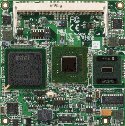 Aaeon COM-945GSE — Dec. 22, 2008 — Aaeon’s COM Express module is powered by Intel’s 1.6GHz N270 Atom processor and aimed at “leading-edge applications” including gaming, entertainment, and industrial automation. The “COM-945GSE” provides eight USB ports, two SATA ports, CRT, LCD, or TV video outputs, and gigabit Ethernet.
Aaeon COM-945GSE — Dec. 22, 2008 — Aaeon’s COM Express module is powered by Intel’s 1.6GHz N270 Atom processor and aimed at “leading-edge applications” including gaming, entertainment, and industrial automation. The “COM-945GSE” provides eight USB ports, two SATA ports, CRT, LCD, or TV video outputs, and gigabit Ethernet. DAVE Qong — Dec. 11, 2008 — German embedded Linux house Denx and Italian turnkey-system vendor DAVE co-developed this computer module and evaluation board aimed at low-power industrial applications. The Denx Linux-ready “Qong” module, which is built into the “Qong EVB-Lite” evaluation board, uses a Freescale i.MX31 SoC.
DAVE Qong — Dec. 11, 2008 — German embedded Linux house Denx and Italian turnkey-system vendor DAVE co-developed this computer module and evaluation board aimed at low-power industrial applications. The Denx Linux-ready “Qong” module, which is built into the “Qong EVB-Lite” evaluation board, uses a Freescale i.MX31 SoC. Eurotech Turbo G5 — Dec. 05, 2008 — Measuring 2.8 x 1.8 inches, this Eurotech computer module is built around a a 532MHz Freescale i.MX31 SoC, and is available with a carrier board. The Turbo G5 runs Linux, with 128MB of RAM, 32MB of flash, plus OpenGL-ES and Direct3D-Mobile graphics acceleration.
Eurotech Turbo G5 — Dec. 05, 2008 — Measuring 2.8 x 1.8 inches, this Eurotech computer module is built around a a 532MHz Freescale i.MX31 SoC, and is available with a carrier board. The Turbo G5 runs Linux, with 128MB of RAM, 32MB of flash, plus OpenGL-ES and Direct3D-Mobile graphics acceleration. Congatec conga-QA — Dec. 02, 2008 — Congatec’s first COM based on the Qseven form-factor targets “ultra-mobile applications.” The conga-QA features Intel Atom Z5xx processors, up to 1GB of DDR2 memory, gigabit Ethernet, eight USB ports, and an optional onboard SSD (solid state drive).
Congatec conga-QA — Dec. 02, 2008 — Congatec’s first COM based on the Qseven form-factor targets “ultra-mobile applications.” The conga-QA features Intel Atom Z5xx processors, up to 1GB of DDR2 memory, gigabit Ethernet, eight USB ports, and an optional onboard SSD (solid state drive). Calao USB-A9G20, QIL-A9G20, and SBC35-A9G20 — Nov. 05, 2008 — These tiny USB, QIL (quad in-line), and processor modules are upgraded versions of earlier Calao Systems, with faster ARM9 processors. Pre-installed with Linux and U-boot, the USB-A9G20, QIL-A9G20, and SBC35-A9G20 modules each incorporate an Atmel AT91SAM9G20 processor clocked to 400MHz.
Calao USB-A9G20, QIL-A9G20, and SBC35-A9G20 — Nov. 05, 2008 — These tiny USB, QIL (quad in-line), and processor modules are upgraded versions of earlier Calao Systems, with faster ARM9 processors. Pre-installed with Linux and U-boot, the USB-A9G20, QIL-A9G20, and SBC35-A9G20 modules each incorporate an Atmel AT91SAM9G20 processor clocked to 400MHz.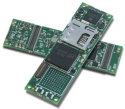 Gumstix Overo Earth — Oct. 28, 2008 — Gumstix’s heir to the popular Verdex SBC is another open-source, gumstick-shaped SBC, but with a more powerful ARM Cortex-A8-based Texas Instruments (TI) OMAP 3503. The Linux-based Overo Earth measures 0.7 x 2.3 x 0.2 inches, 40 percent smaller than the Verdex, and offers 256MB of DDR RAM, 256MB of flash, an on-board microSD adapter, a 24-pin flex ribbon connector for camera control, and dual 70-pin AVX 5602-14 connectors for various functional options.
Gumstix Overo Earth — Oct. 28, 2008 — Gumstix’s heir to the popular Verdex SBC is another open-source, gumstick-shaped SBC, but with a more powerful ARM Cortex-A8-based Texas Instruments (TI) OMAP 3503. The Linux-based Overo Earth measures 0.7 x 2.3 x 0.2 inches, 40 percent smaller than the Verdex, and offers 256MB of DDR RAM, 256MB of flash, an on-board microSD adapter, a 24-pin flex ribbon connector for camera control, and dual 70-pin AVX 5602-14 connectors for various functional options.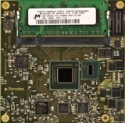 Toradex Woodpecker Z530 and Z510 — Oct. 20, 2008 — This pair of COM Express modules from Toradex is each based on Intel’s Z5xx Atom processors. The Woodpecker Z530 and Z510 modules feature 1.6GHz or 1.1GHz CPUs, respectively, plus six USB 2.0 ports, gigabit Ethernet, dual SATA ports, and microSD slots.
Toradex Woodpecker Z530 and Z510 — Oct. 20, 2008 — This pair of COM Express modules from Toradex is each based on Intel’s Z5xx Atom processors. The Woodpecker Z530 and Z510 modules feature 1.6GHz or 1.1GHz CPUs, respectively, plus six USB 2.0 ports, gigabit Ethernet, dual SATA ports, and microSD slots. TQ Components TQMa31 — Sep. 27, 2008 — This 2.95 by 2.4-inch computer module from TQ Components is equipped with a Freescale i.MX31 SoC and Altera FPGA. The TQMa31 runs Linux, with 256MB of RAM, 1GB of flash, plus CAN, I2C, SPI, and serial interfaces.
TQ Components TQMa31 — Sep. 27, 2008 — This 2.95 by 2.4-inch computer module from TQ Components is equipped with a Freescale i.MX31 SoC and Altera FPGA. The TQMa31 runs Linux, with 256MB of RAM, 1GB of flash, plus CAN, I2C, SPI, and serial interfaces.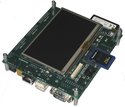 Cogent CSB733 — Sep. 23, 2008 — Cogent Computer Systems’s SO-DIMM-sized computer module is supported by Microcross’s GX-Linux Enterprise Platform for embedded Linux development, and aimed at portable, multimedia-enabled devices. Cogent’s CSB733 is based on Freescale’s i.MX31 SoC clocked to 532Mhz, and offers 128MB of SDRAM and 16MB of SRAM via a 132MHz bus, plus 64MB of NOR flash and 512MB of NAND flash onboard, and multiple I/O connections, including USB, Ethernet, and serial interfaces.
Cogent CSB733 — Sep. 23, 2008 — Cogent Computer Systems’s SO-DIMM-sized computer module is supported by Microcross’s GX-Linux Enterprise Platform for embedded Linux development, and aimed at portable, multimedia-enabled devices. Cogent’s CSB733 is based on Freescale’s i.MX31 SoC clocked to 532Mhz, and offers 128MB of SDRAM and 16MB of SRAM via a 132MHz bus, plus 64MB of NOR flash and 512MB of NAND flash onboard, and multiple I/O connections, including USB, Ethernet, and serial interfaces. Emac SoM-9307M — Sep. 19, 2008 — Emac’s SO-DIMM-sized processor module is built around an ARM9-based Cirrus EP9302 SoC. The SoM-9307M targets development of customized products and applications, and runs Linux, Windows CE 6.0, or the .NET Micro Framework.
Emac SoM-9307M — Sep. 19, 2008 — Emac’s SO-DIMM-sized processor module is built around an ARM9-based Cirrus EP9302 SoC. The SoM-9307M targets development of customized products and applications, and runs Linux, Windows CE 6.0, or the .NET Micro Framework.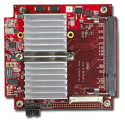 VersaLogic Cheetah EPM-32v — Sep. 10, 2008 — This fanless VersaLogic SBC pulls just eight Watts of power, with separate processor and I/O boards each measuring 3.8 x 3.6 inches. The PC-104/Plus-based Cheetah EPM-32v runs Linux, targeting low-power embedded applications in medicine, avionics, or security.
VersaLogic Cheetah EPM-32v — Sep. 10, 2008 — This fanless VersaLogic SBC pulls just eight Watts of power, with separate processor and I/O boards each measuring 3.8 x 3.6 inches. The PC-104/Plus-based Cheetah EPM-32v runs Linux, targeting low-power embedded applications in medicine, avionics, or security. Lippert CoreExpress-ECO — Sep. 03, 2008 — Lippert’s latest computer-on-module (COM) uses the company’s own 2.3 x 2.6 inch (58 x 65mm) “CoreExpress” COM format. The 28-gram CoreExpress-ECO is available with Intel’s Z530 (1.6GHz) or Z510 (1.1GHz) Atom processors with 2GB RAM, and targets mobile embedded PC applications.
Lippert CoreExpress-ECO — Sep. 03, 2008 — Lippert’s latest computer-on-module (COM) uses the company’s own 2.3 x 2.6 inch (58 x 65mm) “CoreExpress” COM format. The 28-gram CoreExpress-ECO is available with Intel’s Z530 (1.6GHz) or Z510 (1.1GHz) Atom processors with 2GB RAM, and targets mobile embedded PC applications. Axiomtek PICO820 — Sep. 02, 2008 — The self-proclaimed “world’s first pico-ITX SBC” measures 3.9 x 2.8 inches and incorporates a 1.1GHz or 1.6GHz Z5xx Intel Atom CPU. Axiomtek’s PICO820 offers gigabit Ethernet, a SATA port, a VGA port, and headers for four serial ports.
Axiomtek PICO820 — Sep. 02, 2008 — The self-proclaimed “world’s first pico-ITX SBC” measures 3.9 x 2.8 inches and incorporates a 1.1GHz or 1.6GHz Z5xx Intel Atom CPU. Axiomtek’s PICO820 offers gigabit Ethernet, a SATA port, a VGA port, and headers for four serial ports. Linuxstamp’s Linuxstamp — Aug. 07, 2008 — The Linuxstamp is a tiny open-source computer comprised of only six integrated circuits (ICs). Based on an Atmel/ARM9 processor, Linuxstamp’s tiny module ships with freely downloadable kit schematics, and has been demonstrated running a small robot.
Linuxstamp’s Linuxstamp — Aug. 07, 2008 — The Linuxstamp is a tiny open-source computer comprised of only six integrated circuits (ICs). Based on an Atmel/ARM9 processor, Linuxstamp’s tiny module ships with freely downloadable kit schematics, and has been demonstrated running a small robot.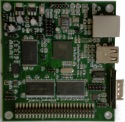 Glomation GESBC-9260 — Aug. 06, 2008 — This ARM9-powered SBC from Glomation runs Linux and costs just $69 in volume. The GESBC-9260 measures 3.75 x 3.5 inches, sports Atmel’s 200MHz AT91SAM9260, and targets “highly connected image processing applications” such as Ethernet-based IP cameras, and bar code readers.
Glomation GESBC-9260 — Aug. 06, 2008 — This ARM9-powered SBC from Glomation runs Linux and costs just $69 in volume. The GESBC-9260 measures 3.75 x 3.5 inches, sports Atmel’s 200MHz AT91SAM9260, and targets “highly connected image processing applications” such as Ethernet-based IP cameras, and bar code readers.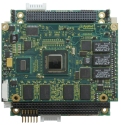 Eurotech Isis — Aug. 01, 2008 — This PC/104-Plus module offers Intel’s Z500-series Atom processors, and an optional 20-channel GPS receiver. Compatible with embedded Linux, Eurotech’s “Isis” includes SDIO and PCI Express Mini Card sockets, PC/104 and PC/104-Plus expansion, and eight USB ports.
Eurotech Isis — Aug. 01, 2008 — This PC/104-Plus module offers Intel’s Z500-series Atom processors, and an optional 20-channel GPS receiver. Compatible with embedded Linux, Eurotech’s “Isis” includes SDIO and PCI Express Mini Card sockets, PC/104 and PC/104-Plus expansion, and eight USB ports. Embedian MXM-8310 and MXM-8110 — Jul. 10, 2008 — These two computer-on-modules (COMs) from Embedian are available with a baseboard that connects via an MXM (Mobile PCI Express Module) connector. The MXM-8310 and MXM-8110 run Debian on a PXA320 (Monahans-P) processor, and offer interfaces for Ethernet, USB, TFT LCD, RS232, CF, and IDE.
Embedian MXM-8310 and MXM-8110 — Jul. 10, 2008 — These two computer-on-modules (COMs) from Embedian are available with a baseboard that connects via an MXM (Mobile PCI Express Module) connector. The MXM-8310 and MXM-8110 run Debian on a PXA320 (Monahans-P) processor, and offer interfaces for Ethernet, USB, TFT LCD, RS232, CF, and IDE.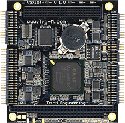 Tri-M Engineering VSX104+ — Jul. 07, 2008 — Tri-M Engineering’s low-cost PC/104-Plus processor module offers dual 10/100 Ethernet ports and measures 3.55 x 3.775 x 0.9 inches. Targeting industrial computing and data collection applications, the rugged, extended-temperature VSX104+ runs Linux, Windows CE, DOS, and popular 32-bit RTOSes on a Vortex86SX SoC clocked at 300MHz.
Tri-M Engineering VSX104+ — Jul. 07, 2008 — Tri-M Engineering’s low-cost PC/104-Plus processor module offers dual 10/100 Ethernet ports and measures 3.55 x 3.775 x 0.9 inches. Targeting industrial computing and data collection applications, the rugged, extended-temperature VSX104+ runs Linux, Windows CE, DOS, and popular 32-bit RTOSes on a Vortex86SX SoC clocked at 300MHz. Via P700 — Jun. 30, 2008 — This Via Technologies motherboard uses its tiny 3.9 x 2.8 inch pico-ITX format, and is available with a 1GHz C7 or 500MHz Eden ULV processor. The P700 boasts an onboard DC-DC adapter, and comes with two daughterboards that add real-world I/O connectors.
Via P700 — Jun. 30, 2008 — This Via Technologies motherboard uses its tiny 3.9 x 2.8 inch pico-ITX format, and is available with a 1GHz C7 or 500MHz Eden ULV processor. The P700 boasts an onboard DC-DC adapter, and comes with two daughterboards that add real-world I/O connectors. E-con eSOM270 — Jun. 20, 2008 — Offered by India-based E-con Systems, this Marvell PXA270-based system on module (SOM) sells for as little as $75. The SODIMM-sized eSOM270 comes pre-installed with Linux, includes 64MB or 128MB of RAM, and has a camera interface and an LCD controller.
E-con eSOM270 — Jun. 20, 2008 — Offered by India-based E-con Systems, this Marvell PXA270-based system on module (SOM) sells for as little as $75. The SODIMM-sized eSOM270 comes pre-installed with Linux, includes 64MB or 128MB of RAM, and has a camera interface and an LCD controller. TI BeagleBoard — Jun. 09, 2008 — This $150 hobbyist board from Texas Instruments (TI) runs Linux on TI’s 600MHz OMAP3530 processor, the fanciest of its ARM Cortex-A8 OMAP35xx SoCs. The 3-inch-square BeagleBoard offers 128MB of 166MHz DDR RAM and 256MB of NAND flash, powers up over USB, and offers multiple interfaces.
TI BeagleBoard — Jun. 09, 2008 — This $150 hobbyist board from Texas Instruments (TI) runs Linux on TI’s 600MHz OMAP3530 processor, the fanciest of its ARM Cortex-A8 OMAP35xx SoCs. The 3-inch-square BeagleBoard offers 128MB of 166MHz DDR RAM and 256MB of NAND flash, powers up over USB, and offers multiple interfaces.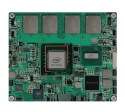 RadiSys Procelerant Z500 — Apr. 30, 2008 — Claimed by RadiSys to be the smallest COM Express device of the time, this Intel Atom-based computer-on-module (COM) measures only 3.4 x 2.75 inches, and targets battery-powered handheld devices. The Procelerant Z500 runs Linux on a 1.1GHz Atom Z510 or 1.6GHz Atom Z530, and provides 1GB of soldered-on RAM and a microSD slot.
RadiSys Procelerant Z500 — Apr. 30, 2008 — Claimed by RadiSys to be the smallest COM Express device of the time, this Intel Atom-based computer-on-module (COM) measures only 3.4 x 2.75 inches, and targets battery-powered handheld devices. The Procelerant Z500 runs Linux on a 1.1GHz Atom Z510 or 1.6GHz Atom Z530, and provides 1GB of soldered-on RAM and a microSD slot. Eurotech Catalyst — Apr. 25, 2008 — This Eurotech Intel Atom-based development system is built around a 3.9 x 2.8-inch computer-on-module (COM). The Catalyst targets ruggedized handheld, medical, and industrial designs, has a wide variety of interfaces, and runs Linux.
Eurotech Catalyst — Apr. 25, 2008 — This Eurotech Intel Atom-based development system is built around a 3.9 x 2.8-inch computer-on-module (COM). The Catalyst targets ruggedized handheld, medical, and industrial designs, has a wide variety of interfaces, and runs Linux. Kontron nanoETXexpress-SP — Apr. 25, 2008 — Kontron’s first nanoETXexpress form-factor COM measures 3.3 x 2.2 inches, and targets demanding handheld applications. The nanoETXexpress-SP uses Intel’s Atom processor, has up to 1GB of RAM and 4GB of flash on board, supports HD video, and offers eight USB ports.
Kontron nanoETXexpress-SP — Apr. 25, 2008 — Kontron’s first nanoETXexpress form-factor COM measures 3.3 x 2.2 inches, and targets demanding handheld applications. The nanoETXexpress-SP uses Intel’s Atom processor, has up to 1GB of RAM and 4GB of flash on board, supports HD video, and offers eight USB ports.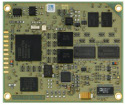 PhyTec PhyCore-LPC3250 — Apr. 24, 2008 — Powered by an ARM9-based, 90nm-fabricated NXP LPC3250 SoC, this PhyTec CPU module targets consumer, medical, industrial, and automotive applications. The PhyCore-LPC3250 weds seven serial ports with “state-of-the-art” power management, and measures a wee 2.75 x 2.3 inches.
PhyTec PhyCore-LPC3250 — Apr. 24, 2008 — Powered by an ARM9-based, 90nm-fabricated NXP LPC3250 SoC, this PhyTec CPU module targets consumer, medical, industrial, and automotive applications. The PhyCore-LPC3250 weds seven serial ports with “state-of-the-art” power management, and measures a wee 2.75 x 2.3 inches. Cogent CSB737 — Apr. 24, 2008 — This SO-DIMM-sized (2.6 x 2.0 inches) computer module from Cogent Computer Systems targets “any size-restricted, low-power embedded system.” Based on Atmel’s AT91SAM9263 processor, the CSB737 runs Linux, and is available with a development kit and carrier board.
Cogent CSB737 — Apr. 24, 2008 — This SO-DIMM-sized (2.6 x 2.0 inches) computer module from Cogent Computer Systems targets “any size-restricted, low-power embedded system.” Based on Atmel’s AT91SAM9263 processor, the CSB737 runs Linux, and is available with a development kit and carrier board.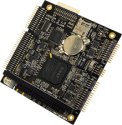 Tri-M Engineering VSX104 — Apr. 22, 2008 — Tri-M Engineering’s low-cost PC/104 processor module measures 3.6 x 3.8 inches and is based on a low-power x86-compatible system-on-chip (SoC). Targeting industrial computing applications, the rugged, extended-temperature VSX104 runs Linux, Windows CE, DOS, and other popular 32-bit RTOSes on a DMP Electronics Vortex86SX SoC clocked at 300MHz.
Tri-M Engineering VSX104 — Apr. 22, 2008 — Tri-M Engineering’s low-cost PC/104 processor module measures 3.6 x 3.8 inches and is based on a low-power x86-compatible system-on-chip (SoC). Targeting industrial computing applications, the rugged, extended-temperature VSX104 runs Linux, Windows CE, DOS, and other popular 32-bit RTOSes on a DMP Electronics Vortex86SX SoC clocked at 300MHz.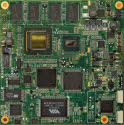 Congatec conga-CA — Apr. 11, 2008 — This Congatec computer-on-module (COM) features an Intel Atom processor and uses the 3.75 x 3.75-inch COM Express form-factor. The conga-CA comes in 1.1GHz and 1.6GHz Atom versions, has two SD sockets on board, features gigabit Ethernet, and offers automatic flat-panel detection.
Congatec conga-CA — Apr. 11, 2008 — This Congatec computer-on-module (COM) features an Intel Atom processor and uses the 3.75 x 3.75-inch COM Express form-factor. The conga-CA comes in 1.1GHz and 1.6GHz Atom versions, has two SD sockets on board, features gigabit Ethernet, and offers automatic flat-panel detection.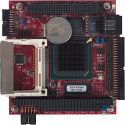 VersaLogic Cheetah and Lynx (RoHS versions) — Apr. 11, 2008 — VersaLogic’s RoHS-compliant versions of its PC-104/Plus-format Cheetah and Lynx modules run Linux, offer recycled and reduced-toxicity materials, and target long-life embedded applications in medicine, avionics, or security. The dual-module Cheetah is based on a 1.6GHz Pentium M, and the single-board Lynx (pictured) uses a 100MHz or 133MHz AMD Elan SC520 processor.
VersaLogic Cheetah and Lynx (RoHS versions) — Apr. 11, 2008 — VersaLogic’s RoHS-compliant versions of its PC-104/Plus-format Cheetah and Lynx modules run Linux, offer recycled and reduced-toxicity materials, and target long-life embedded applications in medicine, avionics, or security. The dual-module Cheetah is based on a 1.6GHz Pentium M, and the single-board Lynx (pictured) uses a 100MHz or 133MHz AMD Elan SC520 processor.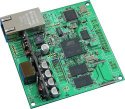 KwikByte KB9260 — Mar. 12, 2008 — KwikByte’s 3.1 x 3.1-inch SBC targets general purpose computing, embedded controls, machine vision, remote monitoring, and database/web servers. The Debian-based KB9260 incorporates a 200MHz ARM9-based AT91SAM9260 processor, offers a variety of I/O interfaces, and costs only $80 in volume.
KwikByte KB9260 — Mar. 12, 2008 — KwikByte’s 3.1 x 3.1-inch SBC targets general purpose computing, embedded controls, machine vision, remote monitoring, and database/web servers. The Debian-based KB9260 incorporates a 200MHz ARM9-based AT91SAM9260 processor, offers a variety of I/O interfaces, and costs only $80 in volume. Acrosser AR-B5020 — Mar. 07, 2008 — Acrosser’s PC/104 form-factor (3.8 x 3.6-in.) SBC is equipped with a 600MHz Celeron M CPU. The fanless, Linux-compatible AR-B5020 can be expanded with an optional daughterboard that adds PC/104 and PCI-104 expansion slots.
Acrosser AR-B5020 — Mar. 07, 2008 — Acrosser’s PC/104 form-factor (3.8 x 3.6-in.) SBC is equipped with a 600MHz Celeron M CPU. The fanless, Linux-compatible AR-B5020 can be expanded with an optional daughterboard that adds PC/104 and PCI-104 expansion slots.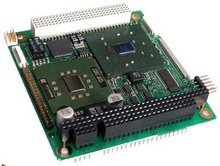 Kontron MOPS-PM — Feb. 29, 2008 — Kontron’s trio of “PM” SBCs includes a 3.8 x 3.6-inch MOPS-PM PC/104-Plus module design. All the PM boards, which include larger EPIC and JRex SBCs are based on Intel 852GM chipsets and Celeron/Pentium M processors.
Kontron MOPS-PM — Feb. 29, 2008 — Kontron’s trio of “PM” SBCs includes a 3.8 x 3.6-inch MOPS-PM PC/104-Plus module design. All the PM boards, which include larger EPIC and JRex SBCs are based on Intel 852GM chipsets and Celeron/Pentium M processors.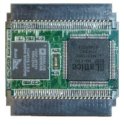 C Data Solutions Compact Computer (CoCo) — Dec. 19, 2007 — This second-generation “computer” based on the CompactFlash (CF) format is designed as a CF card that can plug into any host’s CF slot or control an attached CF bus that developers can populate with other CF-based peripherals. C Data Solutions’s Compact Computer (CoCo) measures 1.65 x 1.45 x 0.2 inches, runs uClinux on a 500MHz Blackfin DSP, and offers programmable I/O via an integrated FPGA.
C Data Solutions Compact Computer (CoCo) — Dec. 19, 2007 — This second-generation “computer” based on the CompactFlash (CF) format is designed as a CF card that can plug into any host’s CF slot or control an attached CF bus that developers can populate with other CF-based peripherals. C Data Solutions’s Compact Computer (CoCo) measures 1.65 x 1.45 x 0.2 inches, runs uClinux on a 500MHz Blackfin DSP, and offers programmable I/O via an integrated FPGA. Icop VSX-6115 — Dec. 18, 2007 — Icop Technology’s “low-power embedded controller” is effectively a complete headless PC crammed onto a board measuring 4 x 2.6 inches. The VSX-6115 runs Linux on a 32-bit x86-compatible Vortex86SX SoC from DMP Electronics, clocked at 300MHz.
Icop VSX-6115 — Dec. 18, 2007 — Icop Technology’s “low-power embedded controller” is effectively a complete headless PC crammed onto a board measuring 4 x 2.6 inches. The VSX-6115 runs Linux on a 32-bit x86-compatible Vortex86SX SoC from DMP Electronics, clocked at 300MHz. Embedian MXM-7110 and MXM-7114 — Nov. 30, 2007 — These two credit-card sized computer modules from Embedian use the 2.60 x 1.97-inch MXM (Mobile PCI Express Module) format, which incorporates a 242-pin “golden finger” connector. The MXM-7110 and graphics-enhanced MXM-7114 (pictured) both run Debian Linux on an ARM9 Samsung S3C2440A SoC clocked to 400MHz, and the MXM-7114 adds a Silicon Motion SM502 graphic chip.
Embedian MXM-7110 and MXM-7114 — Nov. 30, 2007 — These two credit-card sized computer modules from Embedian use the 2.60 x 1.97-inch MXM (Mobile PCI Express Module) format, which incorporates a 242-pin “golden finger” connector. The MXM-7110 and graphics-enhanced MXM-7114 (pictured) both run Debian Linux on an ARM9 Samsung S3C2440A SoC clocked to 400MHz, and the MXM-7114 adds a Silicon Motion SM502 graphic chip.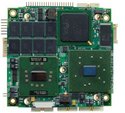 Parvus CPU-1472 and CPU-1474 — Nov. 28, 2007 — These two ruggedized Parvus PC/104-Plus form-factor (3.8 x 3.6-inch) SBCs offer 1GHz Intel Celeron CPUs, and are aimed at military or commercial applications that involve high shock, vibration, and/or temperature extremes. The CPU-1472 (pictured) offers an Ethernet controller and eight USB ports, while the CPU-1474 adds gigabit Ethernet, but is limited to four USB ports.
Parvus CPU-1472 and CPU-1474 — Nov. 28, 2007 — These two ruggedized Parvus PC/104-Plus form-factor (3.8 x 3.6-inch) SBCs offer 1GHz Intel Celeron CPUs, and are aimed at military or commercial applications that involve high shock, vibration, and/or temperature extremes. The CPU-1472 (pictured) offers an Ethernet controller and eight USB ports, while the CPU-1474 adds gigabit Ethernet, but is limited to four USB ports. Tin Can Tools Hammer — Nov. 19, 2007 — Tin Can Tools’s low-cost ARM9 module measures only 0.75 x 2.25 inches, incorporates a 200MHz Samsung S3C2410A SoC, and offers an open hardware design and Linux-based software. Instead of bringing I/O out to high-density surface-mount connectors, the “Hammer” SBC has 40 solder-friendly 0.1-inch pins for easy prototyping of complex designs.
Tin Can Tools Hammer — Nov. 19, 2007 — Tin Can Tools’s low-cost ARM9 module measures only 0.75 x 2.25 inches, incorporates a 200MHz Samsung S3C2410A SoC, and offers an open hardware design and Linux-based software. Instead of bringing I/O out to high-density surface-mount connectors, the “Hammer” SBC has 40 solder-friendly 0.1-inch pins for easy prototyping of complex designs. Phytec PhyCore-i.MX31 — Nov. 15, 2007 — Phytec’s 3.3 x 2.3-inch processor module is aimed at simplifying the development of devices based on Freescale’s highly-integrated i.MX31 SoC. The PhyCore-i.MX31 comes with a Linux BSP, and is optionally available with a carrier board and touchscreen LCD.
Phytec PhyCore-i.MX31 — Nov. 15, 2007 — Phytec’s 3.3 x 2.3-inch processor module is aimed at simplifying the development of devices based on Freescale’s highly-integrated i.MX31 SoC. The PhyCore-i.MX31 comes with a Linux BSP, and is optionally available with a carrier board and touchscreen LCD. Cogent Computer CSB735 — Oct. 22, 2007 — Cogent Computer Systems’s tiny SODIMM-sized embedded computer module is based on Freescale’s i.MX21 SoC. The CSB735 module is supported by Microcross' GX-Linux Enterprise Platform, an embedded Linux development kit for portable multimedia devices.
Cogent Computer CSB735 — Oct. 22, 2007 — Cogent Computer Systems’s tiny SODIMM-sized embedded computer module is based on Freescale’s i.MX21 SoC. The CSB735 module is supported by Microcross' GX-Linux Enterprise Platform, an embedded Linux development kit for portable multimedia devices.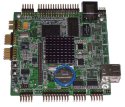 Embest SAM9315V1 — Oct. 15, 2007 — This ARM9-based SBC from Shenzhen-based Embest Info & Tech measures a PC/104-sized 3.8 x 3.5 inches and is based on a ARM9-based Cirrus EP9315 “universal” SoC. The SAM9315V1 also includes a “MaverickCrunch” Math Engine, as well as a raster/LCD controller with 1024 x 768 resolution at up to 24 bits per pixel, and an analog resistive touchscreen interface.
Embest SAM9315V1 — Oct. 15, 2007 — This ARM9-based SBC from Shenzhen-based Embest Info & Tech measures a PC/104-sized 3.8 x 3.5 inches and is based on a ARM9-based Cirrus EP9315 “universal” SoC. The SAM9315V1 also includes a “MaverickCrunch” Math Engine, as well as a raster/LCD controller with 1024 x 768 resolution at up to 24 bits per pixel, and an analog resistive touchscreen interface. CompuLab EM-X270 — Oct. 10, 2007 — CompuLab’s 3.8 x 2.6-inch SBC is based on a Marvell PXA270 processor, and aimed at mobile device applications. The EM-X270 integrates a touchscreen LCD controller, WAN, WLAN, and WPAN wireless, GPS, and an assortment of I/O ports, and is offered with a Linux OS.
CompuLab EM-X270 — Oct. 10, 2007 — CompuLab’s 3.8 x 2.6-inch SBC is based on a Marvell PXA270 processor, and aimed at mobile device applications. The EM-X270 integrates a touchscreen LCD controller, WAN, WLAN, and WPAN wireless, GPS, and an assortment of I/O ports, and is offered with a Linux OS. Intec WildFireMod — Apr 28, 2006 — A tiny ColdFire-powered CPU module claimed to be the smallest Linux SBC with Internet connectivity, a reasonable amount of memory, and “massive control functionality.” The WildFireMod measures 1.9 x 1.7 inches (49 x 44mm), and targets data acquisition systems, communications, electric and internal combustion motor controllers, robotics, automotive, avionics, and industrial control. Details.
Intec WildFireMod — Apr 28, 2006 — A tiny ColdFire-powered CPU module claimed to be the smallest Linux SBC with Internet connectivity, a reasonable amount of memory, and “massive control functionality.” The WildFireMod measures 1.9 x 1.7 inches (49 x 44mm), and targets data acquisition systems, communications, electric and internal combustion motor controllers, robotics, automotive, avionics, and industrial control. Details. Gumstix XM, BT, and Basix options — May 25, 2005 — Gumstix has added extended memory and on-board Bluetooth options to its line of tiny gumstick-shaped XScale SBCs. It has also launched a new low-cost model priced at $99. The company now offers nine “Connex” and “Basix” SBCs priced from $99 to $189. Details
Gumstix XM, BT, and Basix options — May 25, 2005 — Gumstix has added extended memory and on-board Bluetooth options to its line of tiny gumstick-shaped XScale SBCs. It has also launched a new low-cost model priced at $99. The company now offers nine “Connex” and “Basix” SBCs priced from $99 to $189. Details Esfia M170S — Apr 7, 2005 — A low-cost module for POS (point-of-sale/service) devices, RFID tunnel readers, biometric access control terminals, and other test, industrial, and medical applications, the ARM-based M170S measures 2.42 x 1.77 inches (61.5 x 45mm), costs $64, and is available with a wireless-enabled carrier board. details
Esfia M170S — Apr 7, 2005 — A low-cost module for POS (point-of-sale/service) devices, RFID tunnel readers, biometric access control terminals, and other test, industrial, and medical applications, the ARM-based M170S measures 2.42 x 1.77 inches (61.5 x 45mm), costs $64, and is available with a wireless-enabled carrier board. details Kontron X-board GP8 — Mar 10, 2005 — A highly integrated device in the very compact 67 x 49-mm X-board module form-factor. Dubbed the X-board GP8, the board is built around an Intel Xscale 80219 microprocessor and Silicon Motion SM501 chipset. details.
Kontron X-board GP8 — Mar 10, 2005 — A highly integrated device in the very compact 67 x 49-mm X-board module form-factor. Dubbed the X-board GP8, the board is built around an Intel Xscale 80219 microprocessor and Silicon Motion SM501 chipset. details.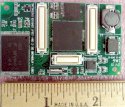 Cogent CSB637 — Mar 3, 2005 — A tiny SBC that measures 1.75 x 2.5 (63.5 x 44.5mm), and is based on an Atmel AT91RM9200, a low-power SoC (system-on-chip) with an ARM920T core that Atmel says delivers 200 MIPS. The Cogent board supplements the Atmel microcontroller’s functionality, according to Direct Insight, offering interfaces that include 10/100 Ethernet MAC and PHY, USB, Dual SDIO, 4 UARTs, SSI, SPI, and CompactFlash Interfaces, an onboard LCD/CRT Controller. Also included are 64MB SDRAM and 8MB flash memory and an “efficient” 3.3V Regulator. details.
Cogent CSB637 — Mar 3, 2005 — A tiny SBC that measures 1.75 x 2.5 (63.5 x 44.5mm), and is based on an Atmel AT91RM9200, a low-power SoC (system-on-chip) with an ARM920T core that Atmel says delivers 200 MIPS. The Cogent board supplements the Atmel microcontroller’s functionality, according to Direct Insight, offering interfaces that include 10/100 Ethernet MAC and PHY, USB, Dual SDIO, 4 UARTs, SSI, SPI, and CompactFlash Interfaces, an onboard LCD/CRT Controller. Also included are 64MB SDRAM and 8MB flash memory and an “efficient” 3.3V Regulator. details.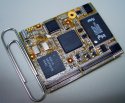 Esfia M170P — Mar 2, 2005 — A tiny ARM7-based SBC that measures just 1.97 x 1.57 inches (50 x 40mm) and costs $64 in quantities of 5,000, the M170P targets rugged handheld devices, and is available with an evaluation kit that includes Linux. details
Esfia M170P — Mar 2, 2005 — A tiny ARM7-based SBC that measures just 1.97 x 1.57 inches (50 x 40mm) and costs $64 in quantities of 5,000, the M170P targets rugged handheld devices, and is available with an evaluation kit that includes Linux. details SSV DIL-40 DNP/5282 — Jan 5, 2005 — The first of a planned family of DIL-40 computer modules that measure 2.2 x 0.9 inches, matching the pin footprint of 40-pin “DIP” (dual-inline-package) ICs. The DNP/5282 is based on a 66MHz Freescale Coldfire processor, and comes preinstalled with uClinux. details.
SSV DIL-40 DNP/5282 — Jan 5, 2005 — The first of a planned family of DIL-40 computer modules that measure 2.2 x 0.9 inches, matching the pin footprint of 40-pin “DIP” (dual-inline-package) ICs. The DNP/5282 is based on a 66MHz Freescale Coldfire processor, and comes preinstalled with uClinux. details. Toradex Colibri — Mar 14, 2005 — An SODIMM format computer module based on the Intel XScale PXA270 processor. The Colibri is optionally available with Linux pre-installed. details
Toradex Colibri — Mar 14, 2005 — An SODIMM format computer module based on the Intel XScale PXA270 processor. The Colibri is optionally available with Linux pre-installed. details AMD GX SOM-144 — Dec 15, 2004 — Based on a Geode GX [email protected] processor, the Geode GX SOM-144 comes with an RDK that includes Linux drivers. It measures 4 x 2.7 inches (100 x 68mm), and targets applications where power, size, performance, and reliability are critical, AMD says. details
AMD GX SOM-144 — Dec 15, 2004 — Based on a Geode GX [email protected] processor, the Geode GX SOM-144 comes with an RDK that includes Linux drivers. It measures 4 x 2.7 inches (100 x 68mm), and targets applications where power, size, performance, and reliability are critical, AMD says. details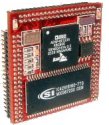 Cambridge Signal Processing (CSP) DSP Stamp — Oct 22, 2004 — A 1-inch-square module based on a digital signal processor (DSP) that runs uClinux natively. The DSP Stamp comes preinstalled with a serial bootloader and uClinux, and a development board is also available. A Bluetooth camera reference design is expected Q4, 2004 details.
Cambridge Signal Processing (CSP) DSP Stamp — Oct 22, 2004 — A 1-inch-square module based on a digital signal processor (DSP) that runs uClinux natively. The DSP Stamp comes preinstalled with a serial bootloader and uClinux, and a development board is also available. A Bluetooth camera reference design is expected Q4, 2004 details. CompuLab ARMcore-GX — Oct 18, 2004 — A tiny low-cost processor module based on a 400MHz Intel PXA255. The ARMcore-GX measures 2.6 x 1.7 inches (66 x 44mm) and costs $51 in quantities of 1,000, and is available with a PC/104 carrier board. details
CompuLab ARMcore-GX — Oct 18, 2004 — A tiny low-cost processor module based on a 400MHz Intel PXA255. The ARMcore-GX measures 2.6 x 1.7 inches (66 x 44mm) and costs $51 in quantities of 1,000, and is available with a PC/104 carrier board. details C Data CompactFlash Computer — Aug 3, 2004 — this tiny Linux-based computer fits entirely on a Type II CompactFlash (CF) card which can be mixed and matched with third-party CF-cards to create miniscule, modular Linux systems based entirely on CF cards. The module is based on a 66MHz Freescale MPC5272 SoC and includes 32MB SDRAM and 8MB flash, and runs uClinux. Details here.
C Data CompactFlash Computer — Aug 3, 2004 — this tiny Linux-based computer fits entirely on a Type II CompactFlash (CF) card which can be mixed and matched with third-party CF-cards to create miniscule, modular Linux systems based entirely on CF cards. The module is based on a 66MHz Freescale MPC5272 SoC and includes 32MB SDRAM and 8MB flash, and runs uClinux. Details here. Kontron E2Brain EB8540 — Jun 28, 2004 — A fanless 4.3 x 2.9-inch RISC-based “computer-on-module” designed to enable Linux and VxWorks device developers to concentrate on product design and application-specific software, rather than on implementing their own processor cores. The E2Brain is based on an 800MHz Freescale MPC8540 PowerQUICC III processor that delivers 1,850 DMIPS. It targets industrial automation, transportation, medical technology, and defense. details
Kontron E2Brain EB8540 — Jun 28, 2004 — A fanless 4.3 x 2.9-inch RISC-based “computer-on-module” designed to enable Linux and VxWorks device developers to concentrate on product design and application-specific software, rather than on implementing their own processor cores. The E2Brain is based on an 800MHz Freescale MPC8540 PowerQUICC III processor that delivers 1,850 DMIPS. It targets industrial automation, transportation, medical technology, and defense. details Strategic Test Triton-Eco — May 27, 2004 — A tiny, inexpensive SBC module based on a 400MHz PXA255, an Intel XScale processor popular in PDAs and smartphones. The Triton-Eco module comes with Linux 2.6 pre-installed, and costs $135/$99 in quantities of 10/1000. details
Strategic Test Triton-Eco — May 27, 2004 — A tiny, inexpensive SBC module based on a 400MHz PXA255, an Intel XScale processor popular in PDAs and smartphones. The Triton-Eco module comes with Linux 2.6 pre-installed, and costs $135/$99 in quantities of 10/1000. details General Micro Systems Spider — Mar 8, 2004 — This standalone SBC measures 2.8 x 1.9 inches, boots from on-board flash, includes a DC-DC converter, and is based on an IBM PowerPC chip running either 400 or 800 MHz. A companion I/O card is available, with dual Ethernet ports and more. The Spider targets distributed control, telecom server blades, handhelds, and military/aerospace applications. details
General Micro Systems Spider — Mar 8, 2004 — This standalone SBC measures 2.8 x 1.9 inches, boots from on-board flash, includes a DC-DC converter, and is based on an IBM PowerPC chip running either 400 or 800 MHz. A companion I/O card is available, with dual Ethernet ports and more. The Spider targets distributed control, telecom server blades, handhelds, and military/aerospace applications. details Aleph One “Balloon” board — Feb 2, 2004 — Aleph One is shipping a one-ounce, one-watt, 206MHz StrongARM-based SBC module that comes pre-installed with embedded Linux and features an “open source” hardware design. Aleph One encourages device designers to freely use the design, and contribute back implementation details useful to others. Aleph One says its “Balloon board” is ideal for use in contol systems, portable devices, wearable computers, instrumentation, and robotics. details.
Aleph One “Balloon” board — Feb 2, 2004 — Aleph One is shipping a one-ounce, one-watt, 206MHz StrongARM-based SBC module that comes pre-installed with embedded Linux and features an “open source” hardware design. Aleph One encourages device designers to freely use the design, and contribute back implementation details useful to others. Aleph One says its “Balloon board” is ideal for use in contol systems, portable devices, wearable computers, instrumentation, and robotics. details.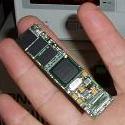 Gumstix — Jan 29, 2004 — This unique SBC module features an oblong shape (20 x 80 mm; 0.79 x 3.1 in.), and targets wearables such as collar PCs, mobile phones, and robotics control. It is based on an an Intel XScale PXA255 processor, and includes 4MB of flash and 64MB of SDRAM. Expansion interfaces include MMC, SD, and SDIO. The board draws under 200mA, according to Gumstix, and can be powered by 3 AAA NiMH batteries. details
Gumstix — Jan 29, 2004 — This unique SBC module features an oblong shape (20 x 80 mm; 0.79 x 3.1 in.), and targets wearables such as collar PCs, mobile phones, and robotics control. It is based on an an Intel XScale PXA255 processor, and includes 4MB of flash and 64MB of SDRAM. Expansion interfaces include MMC, SD, and SDIO. The board draws under 200mA, according to Gumstix, and can be powered by 3 AAA NiMH batteries. details DDC Linux Rocket — Jan 28, 2004 — Data Design Corp claims its micro-miniature SBC module provides a powerful Linux system on a truly tiny board. Based on a PowerPC 405GPr processor clocked up to 400MHz, the “Linux Rocket” includes DDC’s custom PPC Linux kernel and flash filesystem, and targets kiosk, industrial monitoring and control, instrumentation, set-top-box, and vending machine applications. details
DDC Linux Rocket — Jan 28, 2004 — Data Design Corp claims its micro-miniature SBC module provides a powerful Linux system on a truly tiny board. Based on a PowerPC 405GPr processor clocked up to 400MHz, the “Linux Rocket” includes DDC’s custom PPC Linux kernel and flash filesystem, and targets kiosk, industrial monitoring and control, instrumentation, set-top-box, and vending machine applications. details Kontron E2Brain EB425 — Dec 11, 2003 — Claimed to be the first computer-on-module based on Intel’s XScale IXP42x network processor, the EB425 “E2Brain” measures 2.95 by 4.33 inches (75 x 115 mm) and targets low-power real-time applications. It supports Linux and VxWorks. details
Kontron E2Brain EB425 — Dec 11, 2003 — Claimed to be the first computer-on-module based on Intel’s XScale IXP42x network processor, the EB425 “E2Brain” measures 2.95 by 4.33 inches (75 x 115 mm) and targets low-power real-time applications. It supports Linux and VxWorks. details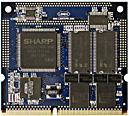 Logic Card Engine — Jan 11, 2003 — a compact (2.37 x 2.67 in.) family of tiny Linux-supported SBC modules that include features such as onboard flash (up to 32MB) and SDRAM (up to 32MB) memory, integrated LCD controller, touch panel support, serial, audio codec, Ethernet, CompactFlash and more. Sharp and Renesas processors are currently supported, and the modules include “production quality” BSPs and bootloaders. details
Logic Card Engine — Jan 11, 2003 — a compact (2.37 x 2.67 in.) family of tiny Linux-supported SBC modules that include features such as onboard flash (up to 32MB) and SDRAM (up to 32MB) memory, integrated LCD controller, touch panel support, serial, audio codec, Ethernet, CompactFlash and more. Sharp and Renesas processors are currently supported, and the modules include “production quality” BSPs and bootloaders. details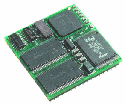 SSV DIL/Net — Oct 18, 2002 — The DIL/Net 1110 (details) is based on a StrongARM 1110 processor, and is available with pre-installed GUI driven by a Linux-based X11 server supporting up to SVGA resolutions. A gum-stick form-factor version (3.2 x 1.1 in.) is also available, as is a gumstick version that runs on a Softcore processor, for Ethernet products with very long life cycles details.
SSV DIL/Net — Oct 18, 2002 — The DIL/Net 1110 (details) is based on a StrongARM 1110 processor, and is available with pre-installed GUI driven by a Linux-based X11 server supporting up to SVGA resolutions. A gum-stick form-factor version (3.2 x 1.1 in.) is also available, as is a gumstick version that runs on a Softcore processor, for Ethernet products with very long life cycles details. HCV Wireless BlueMod — Jun 17, 2002 — this tiny (2.75 x 2.1 in.) SBC module was specifically designed for Bluetooth wireless communication. It runs uClinux on a 32-bit 50 MIPS CPU with 8MB SDRAM and 2MB flash. I/O includes serial, GPIO, USB (device), and connection to external adapters via a processor expansion bus. details
HCV Wireless BlueMod — Jun 17, 2002 — this tiny (2.75 x 2.1 in.) SBC module was specifically designed for Bluetooth wireless communication. It runs uClinux on a 32-bit 50 MIPS CPU with 8MB SDRAM and 2MB flash. I/O includes serial, GPIO, USB (device), and connection to external adapters via a processor expansion bus. details Techsol Medallion — Apr 26, 2002 — a family of tiny (4 square inch) SBC modules. The HY7201 is based on a 60 MHz ARM-720T RISC processor, and includes 32MB of SDRAM and a 32MB DiskOnChip flash disk, plus built-in controllers for 2 UARTs, CRT/LCD VGA, touchscreen, IrDA, USB (host and device), multimedia card, and GPIO. details
Techsol Medallion — Apr 26, 2002 — a family of tiny (4 square inch) SBC modules. The HY7201 is based on a 60 MHz ARM-720T RISC processor, and includes 32MB of SDRAM and a 32MB DiskOnChip flash disk, plus built-in controllers for 2 UARTs, CRT/LCD VGA, touchscreen, IrDA, USB (host and device), multimedia card, and GPIO. details AMC Technologies NETdimm — Mar 6, 2002 — the NETdimm is an SBC module is implemented in AMC’s 5.25 x 1.5 inch dimmPCI form-factor, and is built around a Motorola Dragonball processor equipped with up to 32MB SDRAM and up to 8MB flash. It also features built-in controllers for Ethernet, an LCD, two serial ports, and an SPI port. Other versions are available which replace the NETdimm’s Ethernet and LCD functions with CANbus or digital and analog I/O. The module runs uClinux.
AMC Technologies NETdimm — Mar 6, 2002 — the NETdimm is an SBC module is implemented in AMC’s 5.25 x 1.5 inch dimmPCI form-factor, and is built around a Motorola Dragonball processor equipped with up to 32MB SDRAM and up to 8MB flash. It also features built-in controllers for Ethernet, an LCD, two serial ports, and an SPI port. Other versions are available which replace the NETdimm’s Ethernet and LCD functions with CANbus or digital and analog I/O. The module runs uClinux. Acunia Xingu — Oct 24, 2001 — this 2.7 x 3.6 in. SBC module is based on an Intel Xscale i80200 processor with up to 850 MIPS performance. It includes up to 128MB SDRAM and 32MB flash, plus built-in controllers for video, UART, AC97 Audio codec, PCMCIA, and I2C, and has a power consumption of under 2.5W.
Acunia Xingu — Oct 24, 2001 — this 2.7 x 3.6 in. SBC module is based on an Intel Xscale i80200 processor with up to 850 MIPS performance. It includes up to 128MB SDRAM and 32MB flash, plus built-in controllers for video, UART, AC97 Audio codec, PCMCIA, and I2C, and has a power consumption of under 2.5W. CompuLab 586CORE — Jul 17, 2001 — a tiny (3.1 x 2.4 in.) PC-compatible SBC module based on the AMD Elan SC520. Includes: 16-64 MB DRAM, 1-136M flash disk, 69000-based SVGA graphics, 10/100 Mbit Ethernet, USB, 2-4 serial ports, PS/2 keyboard/mouse, IrDA, 32 digital I/O, RTC, sound, IDE/floppy interfaces, plus ISA and PCI expansion buses. details
CompuLab 586CORE — Jul 17, 2001 — a tiny (3.1 x 2.4 in.) PC-compatible SBC module based on the AMD Elan SC520. Includes: 16-64 MB DRAM, 1-136M flash disk, 69000-based SVGA graphics, 10/100 Mbit Ethernet, USB, 2-4 serial ports, PS/2 keyboard/mouse, IrDA, 32 digital I/O, RTC, sound, IDE/floppy interfaces, plus ISA and PCI expansion buses. details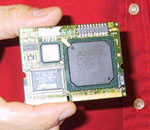 Forth-Systeme DIMM-520, ModNET50 — Apr 27, 2001 — the tiny “DIMM-sized” (2.7 x 2.0 in.) DIMM-520, pictured here, is based on the 32-Bit 133 MHz AMD ElanSC520 x86 system-on-chip. It includes: 64MB SDRAM, 16M flash, PCI bus interface, 2 serial and 1 parallel ports, 100 Mbit Ethernet, and PC motherboard core logic. The ModNET50 uses NetSilicon’s NET+ARM system-on-chip to integrate a RISC processor, 100 Mbit Ethernet, 2 serial ports, RAM, flash, and other functions on a tiny SBC. (a few details of both boards are here)
Forth-Systeme DIMM-520, ModNET50 — Apr 27, 2001 — the tiny “DIMM-sized” (2.7 x 2.0 in.) DIMM-520, pictured here, is based on the 32-Bit 133 MHz AMD ElanSC520 x86 system-on-chip. It includes: 64MB SDRAM, 16M flash, PCI bus interface, 2 serial and 1 parallel ports, 100 Mbit Ethernet, and PC motherboard core logic. The ModNET50 uses NetSilicon’s NET+ARM system-on-chip to integrate a RISC processor, 100 Mbit Ethernet, 2 serial ports, RAM, flash, and other functions on a tiny SBC. (a few details of both boards are here)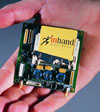 Inhand Fingertip and Elf — Apr 27, 2001 — the tiny (2.75 x 2.75 in.) Fingertip “PDA platform,” pictured here, is based on a 200MHz Intel StrongARM 1110 processor; it also includes: up to 32M flash, up to 16M SDRAM, audio, 3 serial ports, SPI port, USB, 12 digital I/O lines, 320×240 LCD display/touchscreen interface, battery support, and CompactFlash expansion socket. Also based on an SA-1110 processor, the slightly larger (12 square inch) Elf SBC has a built-in PCMCIA slot, 16MB DRAM and up to 8MB flash onboard memory, plus many of the same features as the Fingertip. InHand’s Fingertip3 (details) is the company’s first SBC based on an XScale processor. details
Inhand Fingertip and Elf — Apr 27, 2001 — the tiny (2.75 x 2.75 in.) Fingertip “PDA platform,” pictured here, is based on a 200MHz Intel StrongARM 1110 processor; it also includes: up to 32M flash, up to 16M SDRAM, audio, 3 serial ports, SPI port, USB, 12 digital I/O lines, 320×240 LCD display/touchscreen interface, battery support, and CompactFlash expansion socket. Also based on an SA-1110 processor, the slightly larger (12 square inch) Elf SBC has a built-in PCMCIA slot, 16MB DRAM and up to 8MB flash onboard memory, plus many of the same features as the Fingertip. InHand’s Fingertip3 (details) is the company’s first SBC based on an XScale processor. details TQ-Components TQM850 — Mar 1, 2001 — a tiny (2.1 x 1.8 in.) SBC module based on a 50MHz Motorola PowerPC MPC850. Includes: up to 8MB flash and up to 64MB SDRAM, plus dual-serial and dual-CAN (field bus) interfaces. Expands via 120-pin board-to-board connector on bottom. details
TQ-Components TQM850 — Mar 1, 2001 — a tiny (2.1 x 1.8 in.) SBC module based on a 50MHz Motorola PowerPC MPC850. Includes: up to 8MB flash and up to 64MB SDRAM, plus dual-serial and dual-CAN (field bus) interfaces. Expands via 120-pin board-to-board connector on bottom. details LART — Feb 27, 2001 — an “open licensed” small (4 x 3 in.) design from the Technical University of Delft, Netherlands. The LART module is based on a 220 MHz Intel SA-1100 StrongARM and includes: 4MB flash and 32MB DRAM memory, serial and parallel ports, and bus expansion. Expansion boards provide: Ethernet, USB, keyboard, mouse, touch input, and video. details
LART — Feb 27, 2001 — an “open licensed” small (4 x 3 in.) design from the Technical University of Delft, Netherlands. The LART module is based on a 220 MHz Intel SA-1100 StrongARM and includes: 4MB flash and 32MB DRAM memory, serial and parallel ports, and bus expansion. Expansion boards provide: Ethernet, USB, keyboard, mouse, touch input, and video. details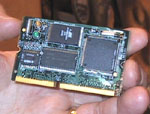 Arcturus Networks uCdimm, uCsimm — Feb 14, 2001 — The soDIMM-sized (1.7 x 2.7 in.) uCdimm SBC module, pictured here, is based on a Motorola DragonBallVZ and provides 2 SPI interfaces, 2 RS232 ports, 22 digital I/O’s, up to 640×512 LCD control, and 10 Mbit Ethernet. The older “SIMM-sized” (3.5 x 1 in.) uCsimm model (details) is based on a Motorola DragonBall 68EZ328 with 2.7 mips performance, and includes: 2MB flash, 8MB DRAM, 21 digital I/O, serial, I2C/SPI, 10 Mbit Ethernet, and a 640×480 LCD controller. details
Arcturus Networks uCdimm, uCsimm — Feb 14, 2001 — The soDIMM-sized (1.7 x 2.7 in.) uCdimm SBC module, pictured here, is based on a Motorola DragonBallVZ and provides 2 SPI interfaces, 2 RS232 ports, 22 digital I/O’s, up to 640×512 LCD control, and 10 Mbit Ethernet. The older “SIMM-sized” (3.5 x 1 in.) uCsimm model (details) is based on a Motorola DragonBall 68EZ328 with 2.7 mips performance, and includes: 2MB flash, 8MB DRAM, 21 digital I/O, serial, I2C/SPI, 10 Mbit Ethernet, and a 640×480 LCD controller. details SNMC QS850 — Aug 14, 2000 — The QuickStart QS850 is a tiny (3.1 x 2.1 in.) networked PowerPC module based on a Motorola MPC850. Includes: 8-64 MB SDRAM, 2-16 MB flash, up to 2 Ethernet ports, 3 serial ports, up to 64 channels HDLC, 49 digital I/O lines. Supported by SNMC’s QSLinux Embedded Linux. details
SNMC QS850 — Aug 14, 2000 — The QuickStart QS850 is a tiny (3.1 x 2.1 in.) networked PowerPC module based on a Motorola MPC850. Includes: 8-64 MB SDRAM, 2-16 MB flash, up to 2 Ethernet ports, 3 serial ports, up to 64 channels HDLC, 49 digital I/O lines. Supported by SNMC’s QSLinux Embedded Linux. details Strategic Test Max-PC — Nov 5, 2000 — A matchbox sized (2.3 x 1.2 in.) module based on a 100MHz 486 processor, plus 16MB RAM and 16MB flash. Onboard controllers handle VGA, RS232 serial, parallel port, timers, keyboard, iRDA, and PCMCIA. details
Strategic Test Max-PC — Nov 5, 2000 — A matchbox sized (2.3 x 1.2 in.) module based on a 100MHz 486 processor, plus 16MB RAM and 16MB flash. Onboard controllers handle VGA, RS232 serial, parallel port, timers, keyboard, iRDA, and PCMCIA. details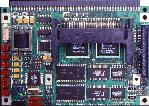 ADS Bitsy — Oct 24, 2000 — this 3 x 4 in. SBC is based on a 206 MHz Intel StrongARM SA-1110 processor (plus SA-1111 companion chip) and consumes just 450 mW. Includes: serial, USB, audio, digital and analog I/O, a Type II PCMCIA slot, plus a 1024 x 1024 resolution color LCD controller. details
ADS Bitsy — Oct 24, 2000 — this 3 x 4 in. SBC is based on a 206 MHz Intel StrongARM SA-1110 processor (plus SA-1111 companion chip) and consumes just 450 mW. Includes: serial, USB, audio, digital and analog I/O, a Type II PCMCIA slot, plus a 1024 x 1024 resolution color LCD controller. details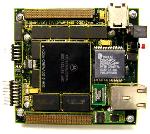 Embedded Planet EP8260 — Oct 4, 2000 — physically, this PowerQUICC II (MPC8260) based SBC matches the footprint of a PC/104 module (3.6 x 3.8 in.) is not considered a PC/104 module. Includes: up to 32MB flash and 128MB SDRAM, 10/100 Ethernet, and a PCMCIA Type II slot. Expandable via the PowerPC expansion bus. details
Embedded Planet EP8260 — Oct 4, 2000 — physically, this PowerQUICC II (MPC8260) based SBC matches the footprint of a PC/104 module (3.6 x 3.8 in.) is not considered a PC/104 module. Includes: up to 32MB flash and 128MB SDRAM, 10/100 Ethernet, and a PCMCIA Type II slot. Expandable via the PowerPC expansion bus. details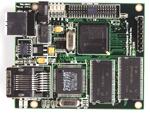 Intrynsic CerfBoard — May 23, 2000 — a tiny (2.2 x 2.4 in.) SBC based on a 133 or 206 MHz Intel StrongARM 1110 CPU. Also includes: up to 16MB flash, up to 8MB SDRAM, 16 digital I/O lines, 10 Mbit Ethernet, USB, serial port, audio CODEC, LCD interface, and CompactFlash+ socket. details
Intrynsic CerfBoard — May 23, 2000 — a tiny (2.2 x 2.4 in.) SBC based on a 133 or 206 MHz Intel StrongARM 1110 CPU. Also includes: up to 16MB flash, up to 8MB SDRAM, 16 digital I/O lines, 10 Mbit Ethernet, USB, serial port, audio CODEC, LCD interface, and CompactFlash+ socket. details JUMPtec DIMM-PC — Sep 21, 1999 — a family of “DIMM form-factor” (2.7 x 1.6 in.) PC-compatible SBC module. The latest DIMM-PC/586 (pictured here) is based on a ZF Micro ZFx86 system-on-chip processor and includes: 32MB SDRAM and 32MB flash memory, plus interfaces for 10/100 Mb/s Ethernet, USB, 2x serial, parallel, keyboard, floppy, and IDE. Earlier models are based on 486 and 386 processors. details
JUMPtec DIMM-PC — Sep 21, 1999 — a family of “DIMM form-factor” (2.7 x 1.6 in.) PC-compatible SBC module. The latest DIMM-PC/586 (pictured here) is based on a ZF Micro ZFx86 system-on-chip processor and includes: 32MB SDRAM and 32MB flash memory, plus interfaces for 10/100 Mb/s Ethernet, USB, 2x serial, parallel, keyboard, floppy, and IDE. Earlier models are based on 486 and 386 processors. detailsStory navigation . . .
- Part 1: About this guide
- Part 2: A Linux-oriented Intro to Embeddable Single Board Computers
- Part 3: PC/104 and PC/104-Plus SBCs
- Part 4: EBX SBCs
- Part 5: Filling the gap between PC/104 and EBX
- Part 6: Teeny weeny Linux SBCs
- Part 7: Mini-ITX madness
This article was originally published on LinuxDevices.com and has been donated to the open source community by QuinStreet Inc. Please visit LinuxToday.com for up-to-date news and articles about Linux and open source.